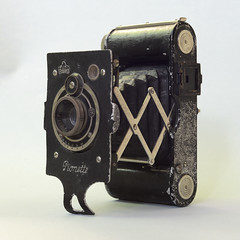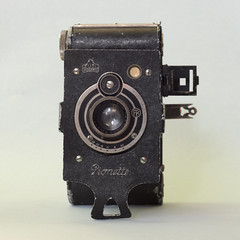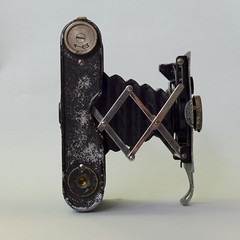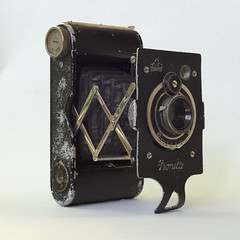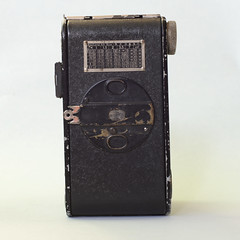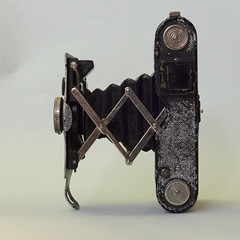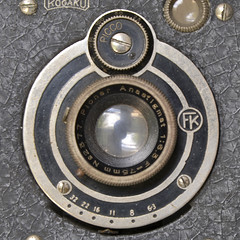Difference between revisions of "Dianette and Pionette"
Rebollo fr (talk | contribs) m (name fix) |
Hanskerensky (talk | contribs) (Added Category:Japanese 127 film) |
||
| (37 intermediate revisions by 3 users not shown) | |||
| Line 1: | Line 1: | ||
{{Japanese Vest | {{Japanese Vest | ||
| − | |image=[http://www.flickr.com/photos/ | + | |image=[http://www.flickr.com/photos/heritagefutures/8186623691/in/pool-camerawiki/ http://farm9.staticflickr.com/8484/8186623691_5f1b0db6cf_m.jpg]<br>''Pionette. {{with permission}}'' |
}} | }} | ||
The '''Dianette''' (ダイアネット) and '''Pionette''' (ピオネット) are Japanese strut-folders taking 4×6.5cm and 3×4cm exposures on [[127 film]], made by [[Fuji Kōgaku]] around 1936. | The '''Dianette''' (ダイアネット) and '''Pionette''' (ピオネット) are Japanese strut-folders taking 4×6.5cm and 3×4cm exposures on [[127 film]], made by [[Fuji Kōgaku]] around 1936. | ||
| Line 10: | Line 10: | ||
The Dianette and Pionette are copies of the [[Pearlette]] by [[Konica|Konishiroku]], itself copied from the German [[Piccolette]] by [[Contessa-Nettel]]. All these cameras were inspired by the [[Vest Pocket Kodak]]. | The Dianette and Pionette are copies of the [[Pearlette]] by [[Konica|Konishiroku]], itself copied from the German [[Piccolette]] by [[Contessa-Nettel]]. All these cameras were inspired by the [[Vest Pocket Kodak]]. | ||
| − | Two body versions are known. | + | {| class="plainlinks" align="center" style="text-align: center;" |
| + | || [http://www.flickr.com/photos/camerawiki/46755248781/in/pool-camerawiki/ http://farm8.staticflickr.com/7862/46755248781_0d25156881_m.jpg] | ||
| + | || [http://www.flickr.com/photos/camerawiki/46702464612/in/pool-camerawiki/ http://farm5.staticflickr.com/4855/46702464612_566fcb0293_m.jpg] | ||
| + | |- | ||
| + | || ''First body type.'' | ||
| + | || ''Second body type.'' | ||
| + | |- | ||
| + | | colspan=2 | ''Dianette, f/6.3 focusing version. {{public domain Japan old}}'' | ||
| + | |} | ||
| + | Two body versions are known. The '''first body type''' is a plain copy of the [[Pearlette]] and [[Piccolette]], with a round cut-off on each side of the body and a front standard extending to the bottom, acting as a standing leg. The '''second body type''' has a rectangular front plate, a retractable standing leg and straight body sides; it is only known with the Dianette name. It presumably replaced the the Pearlette copy, perhaps because the simpler front plate was less costly to manufacture. | ||
{| class="plainlinks" align="center" style="text-align: center;" | {| class="plainlinks" align="center" style="text-align: center;" | ||
| − | || [http://www.flickr.com/photos/ | + | || [http://www.flickr.com/photos/camerawiki/46030539854/in/pool-camerawiki/ http://farm5.staticflickr.com/4827/46030539854_aca39c8859_m.jpg] [http://www.flickr.com/photos/camerawiki/46702792862/in/pool-camerawiki/ http://farm5.staticflickr.com/4867/46702792862_80dab55d2c_m.jpg] [http://www.flickr.com/photos/camerawiki/46755667551/in/pool-camerawiki/ http://farm8.staticflickr.com/7900/46755667551_0a33ed07a7_m.jpg] |
|- | |- | ||
| − | || ''Dianette, f/6.3 focusing version, with | + | || ''Dianette, f/6.3 focusing version, with sports finder. {{public domain Japan old}}'' |
|} | |} | ||
| − | The front standard is mounted on a pair of scissor struts. It has a pivoting [[brilliant finder]] at the top right, as seen from the front; the release button and a thread for a cable release are at the opposite side, behind the front plate. The latter is marked ''Dianette'' or ''Pionette'' at the bottom and has a logo at the top left. The winding knob is at the top right of the main body | + | The front standard is mounted on a pair of scissor struts. It has a pivoting [[brilliant finder]] at the top right, as seen from the front; the release button and a thread for a cable release are at the opposite side, behind the front plate. The latter is marked ''Dianette'' or ''Pionette'' at the bottom and has a logo at the top left. The winding knob is at the top right of the main body — as seen by the photographer holding the camera vertically — and the tripod thread is at the bottom right. |
| − | {| class="plainlinks | + | {| class="plainlinks" align="left" style="text-align: center;" |
| − | || [http://www.flickr.com/photos/ | + | || [http://www.flickr.com/photos/camerawiki/46702883142/in/pool-camerawiki/ http://farm8.staticflickr.com/7816/46702883142_f169ae4c77_m.jpg] |
|- | |- | ||
|| ''Back of the Dianette. {{public domain Japan old}}'' | || ''Back of the Dianette. {{public domain Japan old}}'' | ||
|} | |} | ||
| − | {| class="plainlinks | + | {| class="plainlinks" align="right" width=120px style="text-align: center;" |
| − | || [http://www.flickr.com/photos/ | + | || [http://www.flickr.com/photos/camerawiki/46702914572/in/pool-camerawiki/ http://farm5.staticflickr.com/4851/46702914572_217cc96829_t.jpg] |
|- | |- | ||
|| ''Cable release and exposure insets. {{public domain Japan old}}'' | || ''Cable release and exposure insets. {{public domain Japan old}}'' | ||
|} | |} | ||
| − | The back is hinged to the bottom and has a circular fairing in the middle, containing three red windows: a central one for 4×6.5cm exposures and two outer windows for 3×4cm exposures. These are alternatively hidden by an internal cover, switched by a two-position lever: ''1'' for full-frame, ''2'' for half-frame. The red window fairing also contains a retractable bead for a wireframe finder, apparently mounted | + | The back is hinged to the bottom and has a circular fairing in the middle, containing three red windows: a central one for 4×6.5cm exposures and two outer windows for 3×4cm exposures. These are alternatively hidden by an internal cover, switched by a two-position lever: ''1'' for full-frame, ''2'' for half-frame. The red window fairing also contains a retractable bead for a wireframe finder, apparently mounted on all the models, even those which don't have the wireframe at the front but a sports finder on the side instead. This part inconveniently gets in the way of the central red window, and must be pulled out to read the frame number.<REF name="ACA 01/36"> Column in {{ACA}} January 1936, p.179. </REF> The back has a depth-of-field table attached next to the red window fairing, even on the fixed-focus version.<REF> The undated Dianette leaflet by [[Yamamoto Shashinki-ten]] mentions the presence of a depth-of-field table on all the versions (焦点震度表付). </REF> |
| + | |||
| + | The camera was supplied with a cable release and two exposure insets, one for each format. These insets contain the guide rolls and are indispensable to insure correct film flatness.<REF> Zaisu Ikon, p.4 of {{CCN}} no.226, wonders why the rollers are present for 3×4cm pictures only, presumably because the 4×6.5cm exposure inset is missing on his particular example. </REF> | ||
| + | |||
| + | The camera either has a front-cell '''focusing''' lens and a folding sports finder on the side, or a '''fixed-focus''' lens and a wireframe finder hinged to the front plate. The focusing lens is a Pionar Anastigmat '''f/6.3''' or '''f/4.5''' on the early cameras, later replaced by a Terionar — perhaps a mere rebranding. The fixed-focus lens is an Achromat '''f/8'''. | ||
| − | The | + | The shutter is normally a Picco (T, B, 100, 50, 25) by [[Fuji Kōgaku]]; the speeds are selected by turning a wheel at the top. This wheel is engraved ''PICCO'' on most cameras, though at least one picture shows the name ''FUJIKŌ'' instead,<REF> Picture of the advertisement in {{ACA}} March 1936, p.A25. </REF> and a "Diana" shutter has been reported too.<REF> "Diana" shutter reported in Zaisu Ikon, p.4 of {{CCN}} no.226: シャッターはダイアナ1/25~100、B、T. </REF> |
{{br}} | {{br}} | ||
| + | |||
== Original documents == | == Original documents == | ||
{| class="plainlinks" align="center" style="text-align: center;" | {| class="plainlinks" align="center" style="text-align: center;" | ||
| − | || [http://www.flickr.com/photos/ | + | || [http://www.flickr.com/photos/camerawiki/46760695801/in/pool-camerawiki/ http://farm5.staticflickr.com/4879/46760695801_1e36be6c14_m_d.jpg] [http://www.flickr.com/photos/camerawiki/45845635605/in/pool-camerawiki/ http://farm8.staticflickr.com/7825/45845635605_e8418a6e85_m_d.jpg] [http://www.flickr.com/photos/camerawiki/39795508023/in/pool-camerawiki/ http://farm5.staticflickr.com/4836/39795508023_aeb0ab13de_m_d.jpg] |
|- | |- | ||
| − | || [http://www.flickr.com/photos/ | + | || [http://www.flickr.com/photos/camerawiki/46760839161/in/pool-camerawiki/ http://farm8.staticflickr.com/7860/46760839161_68f22447b5_m_d.jpg] [http://www.flickr.com/photos/camerawiki/46707930702/in/pool-camerawiki/ http://farm5.staticflickr.com/4806/46707930702_4569d64f4e_m_d.jpg] [http://www.flickr.com/photos/camerawiki/45845782525/in/pool-camerawiki/ http://farm8.staticflickr.com/7882/45845782525_40e2262b34_m_d.jpg] |
|- | |- | ||
|| ''Leaflet for the Dianette, date unknown. {{public domain Japan old}}'' | || ''Leaflet for the Dianette, date unknown. {{public domain Japan old}}'' | ||
|} | |} | ||
{| class="plainlinks floatright" width=120px style="text-align: center;" | {| class="plainlinks floatright" width=120px style="text-align: center;" | ||
| − | || [http://www.flickr.com/photos/ | + | || [http://www.flickr.com/photos/camerawiki/31819173567/in/pool-camerawiki/ http://farm5.staticflickr.com/4836/31819173567_aef41489de_m_d.jpg] |
|- | |- | ||
|| ''Picco shutter, ''FUJI OPTISCHE WERK TK'' logo. {{public domain Japan old}}'' | || ''Picco shutter, ''FUJI OPTISCHE WERK TK'' logo. {{public domain Japan old}}'' | ||
|} | |} | ||
| − | An undated leaflet by the distributor [[Yamamoto Shashinki-ten]] presents three versions of the Dianette. All three have a Picco shutter (T, B, 100, 50, 25) | + | An undated leaflet by the distributor [[Yamamoto Shashinki-ten]] presents three versions of the Dianette, with the first body type. All three have a Picco shutter (T, B, 100, 50, 25). The two most expensive versions have the folding sports finder and a Pionar Anastigmat front-cell focusing lens, either f/4.5 (¥38) or f/6.3 (¥28). The cheapest version (¥17) has the wireframe finder and a fixed-focus Fuji-Optical Achromat 75mm f/8, merely engraved ''Fuji–Optical Achromat F=75mm''. In the leaflet, only the f/6.3 and f/8 versions are pictured, both with a round logo reading ''FUJI OPTISCHE WERK'' and ''TK''. One serial number for the Pionar f/6.3 lens is legible as 1450, a very low figure. |
| + | |||
| + | {| class="plainlinks" align="center" style="text-align: center;" | ||
| + | || [http://www.flickr.com/photos/camerawiki/45847992085/in/pool-camerawiki/ http://farm5.staticflickr.com/4808/45847992085_bf85b07871.jpg] | ||
| + | |- | ||
| + | || ''Announcement of the Pionette in {{ACA}} January 1936. {{public domain Japan old}}'' | ||
| + | |} | ||
| + | |||
| + | The Pionette was featured as a new product in the January 1936 issue of {{ACA}}, reproduced above.<REF name="ACA 01/36" /> The document only mentions the version with f/6.3 focusing lens, and gives the price of {{yen|27|1936}}. It shows a small picture of the Pionette, with the first body type and round logo. | ||
| + | |||
| + | {| class="plainlinks" align="center" style="text-align: center;" | ||
| + | || [http://www.flickr.com/photos/camerawiki/39764431993/in/pool-camerawiki/ http://farm5.staticflickr.com/4853/39764431993_2087ea1fee.jpg] | ||
| + | |- | ||
| + | || ''Advertisement in {{ACA}} February and March 1936. {{public domain Japan old}}'' | ||
| + | |} | ||
| + | |||
| + | Advertisements for the Dianette and Pionette were placed in the February to April 1936 issues of {{ACA}}. The advertisement used in February and March is the same.<REF> Advertisement in {{ACA}} February 1936, p.A25, and March 1936, p.A25, also reproduced in {{Kokusan}}, p.77. </REF> It only lists the f/6.3 focusing model, and quotes the price as {{yen|28|1936}}, slightly higher than in January. The picture shows a Dianette with the first body type, similar to that pictured in the leaflet but with a newer logo, shaped as a mountain and reading ''FUJI KOGAKU''; this logo is found on later products of the same company and probably replaced the previous one. On the pictured camera, the shutter dial has a ''FUJIKŌ'' marking instead of the usual ''PICCO''. | ||
| + | |||
| + | {| class="plainlinks" align="center" style="text-align: center;" | ||
| + | || [http://www.flickr.com/photos/camerawiki/31821397947/in/pool-camerawiki/ http://farm8.staticflickr.com/7815/31821397947_f82732bba8.jpg] [http://www.flickr.com/photos/camerawiki/32887601928/in/pool-camerawiki/ http://farm5.staticflickr.com/4821/32887601928_67a0f667e7.jpg] | ||
| + | |- | ||
| + | || ''Advertisements in {{ACA}} April 1936. {{public domain Japan old}}'' | ||
| + | |} | ||
| − | The camera | + | The April 1936 issue of the magazine unusually has two separate advertisements for the Dianette and Pionette; one of these mentions the camera as '''modified''' (改造型).<REF> Advertisements in {{ACA}} April 1936; one is on p.A24 and the other has no page number. </REF> Both documents list the f/4.5 and f/6.3 focusing models, respectively priced at {{yen|38|1936}} and {{yen|28|1936}}. The pictured camera is an f/6.3 Dianette on one document, and an f/4.5 Dianette on the other. They have the second body type, with a folding sports finder in the middle of the side plate, and [[Fuji Kōgaku]]'s "mountain" logo. Unlike other cameras with the second body type, these two early examples do not have any pulling grips on the sides of the front plate. |
| + | |||
| + | The camera was reportedly featured again in the new products column of {{ACA}} in June 1936,<REF name="Kokusan 337"> {{Kokusan}}, p.337. </REF> perhaps because of the newer body shape. The camera was no longer mentioned after that date,<REF name="Kokusan 337" /> and was probably withdrawn within a few months. | ||
== Actual examples == | == Actual examples == | ||
=== Plain Pearlette copy === | === Plain Pearlette copy === | ||
| − | Surviving examples of the plain Pearlette copy are known with the names Dianette and Pionette. It seems that the early examples have the round logo reading ''TK'' and ''FUJI OPTISCHE WERK'', and the later ones have the mountain-shaped logo. | + | Surviving examples of the first body type (plain Pearlette copy) are known with the names Dianette and Pionette. It seems that the early examples have the round logo reading ''TK'' and ''FUJI OPTISCHE WERK'', and the later ones have the mountain-shaped ''FUJI KOGAKU'' logo. |
| − | + | ==== Focusing version ==== | |
| + | Both the Dianette and Pionette have been observed with the round logo, Picco shutter and Pionar f/6.3 focusing lens.<REF> Dianette pictured in [http://asacame.blog61.fc2.com/blog-entry-28.html this page] at Asacame's blog, and Pionette advertised for sale by Tanaka Shōkai on p.27 of {{CCN}} no.223. </REF> A Dianette is also known with the round logo, Pionar f/6.3 lens and a shutter reported as a "Diana", perhaps by mistake.<REF> Example pictured in Zaisu Ikon, p.4 of {{CCN}} no.226. </REF> | ||
| − | + | An example of the Pionette has been observed with the later mountain-shaped logo, a Picco shutter and the Pionar f/6.3 focusing lens.<ref>Photographica Collection Dirk HR Spennemann</ref> | |
| + | |||
| + | Two examples of the focusing Pionette are pictured in {{SUG}}, with the later mountain-shaped logo. Both are said to have a Picco shutter. One of them reportedly has a Terionar f/6.3 lens; its logo is partly erased and its sports finder is missing.<REF> {{SUG}}, item 1223. </REF> The other reportedly has a Terionar f/4.5 lens; its folding sports finder has four prongs indicating the field of view for 3×4cm exposures.<REF> {{SUG}}, item 1222, where it is called "Pionette (Deluxe)". The shutter is called "Pico", certainly by mistake. </REF> | ||
| + | |||
| + | {|class=plainlinks align=center | ||
| + | || | ||
| + | {{Flickr_image | ||
| + | |image_source= http://www.flickr.com/photos/heritagefutures/8187734218/in/pool-camerawiki | ||
| + | |image= http://farm6.static.flickr.com/8485/8187734218_31d4b8b066_m.jpg | ||
| + | |image_align= center | ||
| + | }} | ||
| + | || | ||
| + | {{Flickr_image | ||
| + | |image_source= http://www.flickr.com/photos/heritagefutures/8186637871/in/pool-camerawiki | ||
| + | |image= http://farm6.static.flickr.com/8483/8186637871_0baa0ee283_m.jpg | ||
| + | |image_align= center | ||
| + | }} | ||
| + | || | ||
| + | {{Flickr_image | ||
| + | |image_source= http://www.flickr.com/photos/heritagefutures/8187701578/in/pool-camerawiki | ||
| + | |image= http://farm6.static.flickr.com/8350/8187701578_b7ee5242f1_m.jpg | ||
| + | |image_align= center | ||
| + | }} | ||
| + | |- | ||
| + | || | ||
| + | {{Flickr_image | ||
| + | |image_source= http://www.flickr.com/photos/heritagefutures/8187714466/in/pool-camerawiki | ||
| + | |image= http://farm6.static.flickr.com/8484/8187714466_b8de66d951_m.jpg | ||
| + | |image_align= center | ||
| + | }} | ||
| + | || | ||
| + | {{Flickr_image | ||
| + | |image_source= http://www.flickr.com/photos/heritagefutures/8187709474/in/pool-camerawiki | ||
| + | |image= http://farm6.static.flickr.com/8059/8187709474_b91c311b6d_m.jpg | ||
| + | |image_align= center | ||
| + | }} | ||
| + | || | ||
| + | {{Flickr_image | ||
| + | |image_source= http://www.flickr.com/photos/heritagefutures/8186678791/in/pool-camerawiki | ||
| + | |image= http://farm6.static.flickr.com/8490/8186678791_5750b629a2_m.jpg | ||
| + | |image_align= top | ||
| + | }} | ||
| + | |- | ||
| + | |colspan=3 align="center"| | ||
| + | {{Flickr_image_caption | ||
| + | |image_text= Fuji Kogaku PIonette, focussing version with Pionar Anastigmat 75mm f/6.3 in Picco shutter | ||
| + | |image_by= Dirk HR Spennemann | ||
| + | |image_rights= with permission | ||
| + | }} | ||
| + | |} | ||
| − | One example of the | + | ==== Fixed-focus version ==== |
| + | One example of the fixed-focus Pionette is pictured in {{SUG}}; this same example is also pictured in an issue of {{CCN}}.<REF> {{SUG}}, item 1224, and Zaisu Ikon, p.6 of {{CCN}} no.64. The information on this camera is repeated in {{MK}}, p.329. </REF> Except for the name, it is externally similar to the fixed-focus Dianette pictured in the above leaflet, with the wireframe finder and round logo. In {{SUG}}, the shutter is reported as a Super giving B, 25–500 speeds; the top speed is obviously mistaken, and the shutter name itself is dubious.<REF> In the article in {{CCN}}, the speeds are given as 25–100, B, T but the shutter name is not mentioned. </REF> The lens is engraved ''Fuji–Optical Achromat F=75mm'' with no mention of the aperture, the same as in the leaflet. It is reported as having f/11 aperture, probably another mistake for f/8.<REF> The aperture is not mentioned in the article in {{CCN}}. </REF> | ||
| − | + | Another example of the fixed-focus Pionette is pictured in [http://www.paw.hi-ho.ne.jp/konrin/camera.html this page at Konrin's Garage]. It is similar to the previous example, but for a different silver lens rim. | |
=== Rectangular front plate === | === Rectangular front plate === | ||
| − | + | Only the Dianette is known with the second body type. All the examples have the mountain-shaped ''FUJI KOGAKU'' logo, and small pulling grips on both sides of the front plate. | |
| − | One | + | ==== Focusing version ==== |
| + | Most examples have a focusing lens. One is pictured in an article in {{CCN}}; its lens is reported as a Terionar f/4.5 and its folding optical finder is certainly not original.<REF> Zaisu Ikon, p.3 of {{CCN}} no.226. </REF> Another is pictured in {{MK}}, perhaps with an f/4.5 lens; it has a folding sports finder attached to the middle of the body side is perhaps original.<REF> Example pictured in {{MK}}, p.328. </REF> Yet another is pictured in [https://web.archive.org/web/20160306154111/http://cameraguild.jp/nekosan/9909.htm this page of Nekosan's website (archived)]. | ||
| − | + | ==== Fixed-focus version ==== | |
| + | One camera is pictured in {{SUG}} with a fixed-focus lens engraved ''Fuji–Optical Achromat F=75mm''; the front part of the wireframe finder is probably missing.<REF> {{SUG}}, item 1037. The lens name is wrongly reported as "Fuji-Koki-Achromat". </REF> | ||
== Notes == | == Notes == | ||
| Line 73: | Line 164: | ||
== Bibliography == | == Bibliography == | ||
| + | === Original documents === | ||
| + | * {{ACA}} January 1936. "Atarashii kikai to zairyō" (新しい機械と材料, New equipment and machinery). P.179. | ||
| + | * {{ACA}}. Advertisements by [[Fuji Kōgaku]]: | ||
| + | ** February 1936, p.A25; | ||
| + | ** March 1936, p.A25; | ||
| + | ** April 1936, p.A24; | ||
| + | ** April 1936, no page number. | ||
| + | * [[Yamamoto Shashinki-ten]]. Leaflet for the Dianette. Date not indicated. Document reproduced in [https://www.flickr.com/photos/camerawiki/albums/72157712047063277/ this Flickr album] by Rebollo_fr. | ||
| + | |||
| + | === Recent sources === | ||
* {{Showa10}} Items 137 and 187. | * {{Showa10}} Items 137 and 187. | ||
* {{McKeown12}} Pp.328–9. | * {{McKeown12}} Pp.328–9. | ||
* {{Zukan}} Items 1037 and 1222–4. | * {{Zukan}} Items 1037 and 1222–4. | ||
* Tanaka Shōkai (田中商会). Advertisement in {{CCN}} no.223 (January 1996). Nishinomiya: Camera Collectors News-sha. P.27. | * Tanaka Shōkai (田中商会). Advertisement in {{CCN}} no.223 (January 1996). Nishinomiya: Camera Collectors News-sha. P.27. | ||
| − | |||
* Zaisu Ikon (座椅子遺恨, probably a pseudonym of Y. Saji). "Besuto sanka (P)" (ベスト讃歌[P], Vest hymn [P]). In {{CCN}} no.64 (October 1982). Nishinomiya: Camera Collectors News-sha. P.6. | * Zaisu Ikon (座椅子遺恨, probably a pseudonym of Y. Saji). "Besuto sanka (P)" (ベスト讃歌[P], Vest hymn [P]). In {{CCN}} no.64 (October 1982). Nishinomiya: Camera Collectors News-sha. P.6. | ||
* Zaisu Ikon (座椅子遺恨, probably a pseudonym of Y. Saji). "Tsuzuki Besuto sanka (D)" (続ベスト讃歌[D], Vest hymn continued [D]). In {{CCN}} no.226 (April 1996). Nishinomiya: Camera Collectors News-sha. Pp.3–4. | * Zaisu Ikon (座椅子遺恨, probably a pseudonym of Y. Saji). "Tsuzuki Besuto sanka (D)" (続ベスト讃歌[D], Vest hymn continued [D]). In {{CCN}} no.226 (April 1996). Nishinomiya: Camera Collectors News-sha. Pp.3–4. | ||
| Line 83: | Line 183: | ||
== Links == | == Links == | ||
In Japanese: | In Japanese: | ||
| − | * [http:// | + | * [http://konrin.com/camera.html Pionette, first body type, fixed-focus] at [http://konrin.com/index.html Konrin's Garage] |
| − | * [http:// | + | * [http://asacame.blog61.fc2.com/blog-entry-28.html Dianette, first body type, focusing f/6.3], in [http://asacame.blog61.fc2.com/ Asacame's blog] |
| + | * [https://web.archive.org/web/20160306154111/http://cameraguild.jp/nekosan/9909.htm Japanese prewar 127 film cameras], including the Dianette (second body type), at [https://web.archive.org/web/20160222013353/http://www.cameraguild.jp/nekosan/index.htm Nekosan's website] (archived) | ||
| Line 91: | Line 192: | ||
[[Category: Japanese 4x6.5 viewfinder folding]] | [[Category: Japanese 4x6.5 viewfinder folding]] | ||
[[Category: 4x6.5 strut folding]] | [[Category: 4x6.5 strut folding]] | ||
| + | [[Category:Japanese 127 film]] | ||
[[Category: Fuji Kōgaku]] | [[Category: Fuji Kōgaku]] | ||
[[Category: D]] | [[Category: D]] | ||
[[Category: 1936]] | [[Category: 1936]] | ||
[[Category: P|Pionette]] | [[Category: P|Pionette]] | ||
Latest revision as of 05:47, 28 January 2023
The Dianette (ダイアネット) and Pionette (ピオネット) are Japanese strut-folders taking 4×6.5cm and 3×4cm exposures on 127 film, made by Fuji Kōgaku around 1936.
Contents
Name
The Dianette was certainly distributed by Yamamoto Shashinki-ten, based in Osaka,[1] whereas the brand name Pionette was likely owned by the manufacturer Fuji Kōgaku, based in Tokyo.[2] This is perhaps why some sources say that the camera was sold as Pionette in Kantō (Eastern Japan) and Dianette in Kansai (Western Japan).[3]
General description
The Dianette and Pionette are copies of the Pearlette by Konishiroku, itself copied from the German Piccolette by Contessa-Nettel. All these cameras were inspired by the Vest Pocket Kodak.
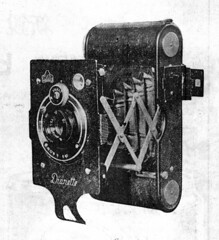
|
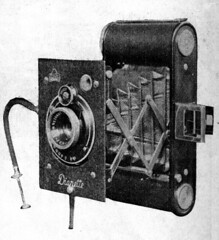
|
| First body type. | Second body type. |
| Dianette, f/6.3 focusing version. (Image rights) | |
Two body versions are known. The first body type is a plain copy of the Pearlette and Piccolette, with a round cut-off on each side of the body and a front standard extending to the bottom, acting as a standing leg. The second body type has a rectangular front plate, a retractable standing leg and straight body sides; it is only known with the Dianette name. It presumably replaced the the Pearlette copy, perhaps because the simpler front plate was less costly to manufacture.
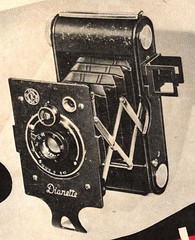 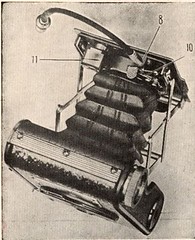 
|
| Dianette, f/6.3 focusing version, with sports finder. (Image rights) |
The front standard is mounted on a pair of scissor struts. It has a pivoting brilliant finder at the top right, as seen from the front; the release button and a thread for a cable release are at the opposite side, behind the front plate. The latter is marked Dianette or Pionette at the bottom and has a logo at the top left. The winding knob is at the top right of the main body — as seen by the photographer holding the camera vertically — and the tripod thread is at the bottom right.
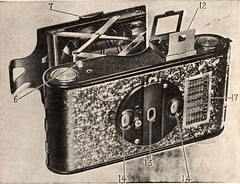
|
| Back of the Dianette. (Image rights) |

|
| Cable release and exposure insets. (Image rights) |
The back is hinged to the bottom and has a circular fairing in the middle, containing three red windows: a central one for 4×6.5cm exposures and two outer windows for 3×4cm exposures. These are alternatively hidden by an internal cover, switched by a two-position lever: 1 for full-frame, 2 for half-frame. The red window fairing also contains a retractable bead for a wireframe finder, apparently mounted on all the models, even those which don't have the wireframe at the front but a sports finder on the side instead. This part inconveniently gets in the way of the central red window, and must be pulled out to read the frame number.[4] The back has a depth-of-field table attached next to the red window fairing, even on the fixed-focus version.[5]
The camera was supplied with a cable release and two exposure insets, one for each format. These insets contain the guide rolls and are indispensable to insure correct film flatness.[6]
The camera either has a front-cell focusing lens and a folding sports finder on the side, or a fixed-focus lens and a wireframe finder hinged to the front plate. The focusing lens is a Pionar Anastigmat f/6.3 or f/4.5 on the early cameras, later replaced by a Terionar — perhaps a mere rebranding. The fixed-focus lens is an Achromat f/8.
The shutter is normally a Picco (T, B, 100, 50, 25) by Fuji Kōgaku; the speeds are selected by turning a wheel at the top. This wheel is engraved PICCO on most cameras, though at least one picture shows the name FUJIKŌ instead,[7] and a "Diana" shutter has been reported too.[8]
Original documents
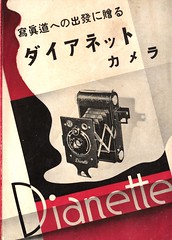 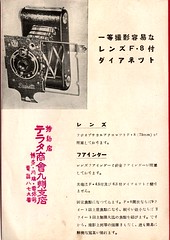 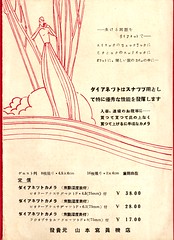
|
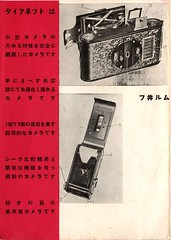 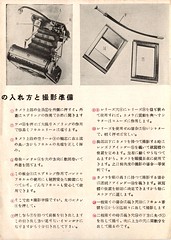 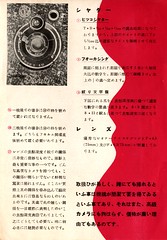
|
| Leaflet for the Dianette, date unknown. (Image rights) |
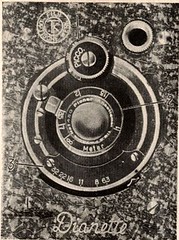
|
| Picco shutter, FUJI OPTISCHE WERK TK logo. (Image rights) |
An undated leaflet by the distributor Yamamoto Shashinki-ten presents three versions of the Dianette, with the first body type. All three have a Picco shutter (T, B, 100, 50, 25). The two most expensive versions have the folding sports finder and a Pionar Anastigmat front-cell focusing lens, either f/4.5 (¥38) or f/6.3 (¥28). The cheapest version (¥17) has the wireframe finder and a fixed-focus Fuji-Optical Achromat 75mm f/8, merely engraved Fuji–Optical Achromat F=75mm. In the leaflet, only the f/6.3 and f/8 versions are pictured, both with a round logo reading FUJI OPTISCHE WERK and TK. One serial number for the Pionar f/6.3 lens is legible as 1450, a very low figure.

|
| Announcement of the Pionette in Asahi Camera January 1936. (Image rights) |
The Pionette was featured as a new product in the January 1936 issue of Asahi Camera, reproduced above.[4] The document only mentions the version with f/6.3 focusing lens, and gives the price of ¥27. It shows a small picture of the Pionette, with the first body type and round logo.
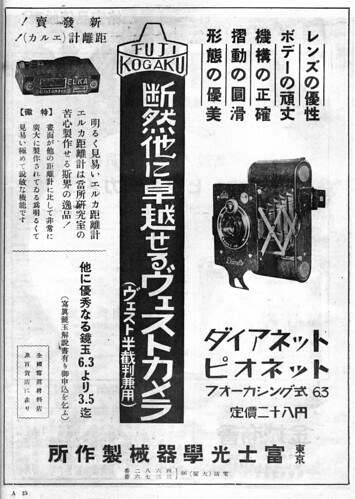
|
| Advertisement in Asahi Camera February and March 1936. (Image rights) |
Advertisements for the Dianette and Pionette were placed in the February to April 1936 issues of Asahi Camera. The advertisement used in February and March is the same.[9] It only lists the f/6.3 focusing model, and quotes the price as ¥28, slightly higher than in January. The picture shows a Dianette with the first body type, similar to that pictured in the leaflet but with a newer logo, shaped as a mountain and reading FUJI KOGAKU; this logo is found on later products of the same company and probably replaced the previous one. On the pictured camera, the shutter dial has a FUJIKŌ marking instead of the usual PICCO.
 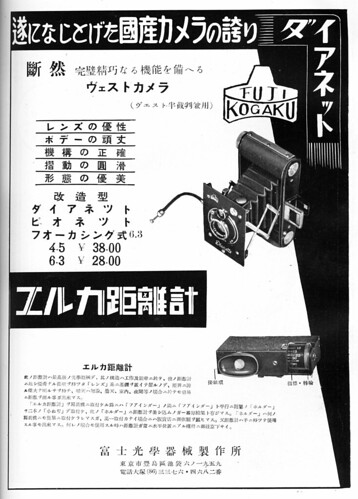
|
| Advertisements in Asahi Camera April 1936. (Image rights) |
The April 1936 issue of the magazine unusually has two separate advertisements for the Dianette and Pionette; one of these mentions the camera as modified (改造型).[10] Both documents list the f/4.5 and f/6.3 focusing models, respectively priced at ¥38 and ¥28. The pictured camera is an f/6.3 Dianette on one document, and an f/4.5 Dianette on the other. They have the second body type, with a folding sports finder in the middle of the side plate, and Fuji Kōgaku's "mountain" logo. Unlike other cameras with the second body type, these two early examples do not have any pulling grips on the sides of the front plate.
The camera was reportedly featured again in the new products column of Asahi Camera in June 1936,[11] perhaps because of the newer body shape. The camera was no longer mentioned after that date,[11] and was probably withdrawn within a few months.
Actual examples
Plain Pearlette copy
Surviving examples of the first body type (plain Pearlette copy) are known with the names Dianette and Pionette. It seems that the early examples have the round logo reading TK and FUJI OPTISCHE WERK, and the later ones have the mountain-shaped FUJI KOGAKU logo.
Focusing version
Both the Dianette and Pionette have been observed with the round logo, Picco shutter and Pionar f/6.3 focusing lens.[12] A Dianette is also known with the round logo, Pionar f/6.3 lens and a shutter reported as a "Diana", perhaps by mistake.[13]
An example of the Pionette has been observed with the later mountain-shaped logo, a Picco shutter and the Pionar f/6.3 focusing lens.[14]
Two examples of the focusing Pionette are pictured in Sugiyama, with the later mountain-shaped logo. Both are said to have a Picco shutter. One of them reportedly has a Terionar f/6.3 lens; its logo is partly erased and its sports finder is missing.[15] The other reportedly has a Terionar f/4.5 lens; its folding sports finder has four prongs indicating the field of view for 3×4cm exposures.[16]
|
|
| ||||||
|
|
| ||||||
|
Fuji Kogaku PIonette, focussing version with Pionar Anastigmat 75mm f/6.3 in Picco shutter | ||||||||
Fixed-focus version
One example of the fixed-focus Pionette is pictured in Sugiyama; this same example is also pictured in an issue of Camera Collectors' News.[17] Except for the name, it is externally similar to the fixed-focus Dianette pictured in the above leaflet, with the wireframe finder and round logo. In Sugiyama, the shutter is reported as a Super giving B, 25–500 speeds; the top speed is obviously mistaken, and the shutter name itself is dubious.[18] The lens is engraved Fuji–Optical Achromat F=75mm with no mention of the aperture, the same as in the leaflet. It is reported as having f/11 aperture, probably another mistake for f/8.[19]
Another example of the fixed-focus Pionette is pictured in this page at Konrin's Garage. It is similar to the previous example, but for a different silver lens rim.
Rectangular front plate
Only the Dianette is known with the second body type. All the examples have the mountain-shaped FUJI KOGAKU logo, and small pulling grips on both sides of the front plate.
Focusing version
Most examples have a focusing lens. One is pictured in an article in Camera Collectors' News; its lens is reported as a Terionar f/4.5 and its folding optical finder is certainly not original.[20] Another is pictured in McKeown, perhaps with an f/4.5 lens; it has a folding sports finder attached to the middle of the body side is perhaps original.[21] Yet another is pictured in this page of Nekosan's website (archived).
Fixed-focus version
One camera is pictured in Sugiyama with a fixed-focus lens engraved Fuji–Optical Achromat F=75mm; the front part of the wireframe finder is probably missing.[22]
Notes
- ↑ A leaflet for the Dianette, reproduced in this article, was published by Yamamoto Shashinki-ten.
- ↑ Fuji Kōgaku used the lens name Pionar, close to Pionette.
- ↑ Pionette in Kantō, Dianette in Kansai: Zaisu Ikon, p.6 of Camera Collectors' News no.64; Kokusan kamera no rekishi, p.337.
- ↑ 4.0 4.1 Column in Asahi Camera January 1936, p.179.
- ↑ The undated Dianette leaflet by Yamamoto Shashinki-ten mentions the presence of a depth-of-field table on all the versions (焦点震度表付).
- ↑ Zaisu Ikon, p.4 of Camera Collectors' News no.226, wonders why the rollers are present for 3×4cm pictures only, presumably because the 4×6.5cm exposure inset is missing on his particular example.
- ↑ Picture of the advertisement in Asahi Camera March 1936, p.A25.
- ↑ "Diana" shutter reported in Zaisu Ikon, p.4 of Camera Collectors' News no.226: シャッターはダイアナ1/25~100、B、T.
- ↑ Advertisement in Asahi Camera February 1936, p.A25, and March 1936, p.A25, also reproduced in Kokusan kamera no rekishi, p.77.
- ↑ Advertisements in Asahi Camera April 1936; one is on p.A24 and the other has no page number.
- ↑ 11.0 11.1 Kokusan kamera no rekishi, p.337.
- ↑ Dianette pictured in this page at Asacame's blog, and Pionette advertised for sale by Tanaka Shōkai on p.27 of Camera Collectors' News no.223.
- ↑ Example pictured in Zaisu Ikon, p.4 of Camera Collectors' News no.226.
- ↑ Photographica Collection Dirk HR Spennemann
- ↑ Sugiyama, item 1223.
- ↑ Sugiyama, item 1222, where it is called "Pionette (Deluxe)". The shutter is called "Pico", certainly by mistake.
- ↑ Sugiyama, item 1224, and Zaisu Ikon, p.6 of Camera Collectors' News no.64. The information on this camera is repeated in McKeown, p.329.
- ↑ In the article in Camera Collectors' News, the speeds are given as 25–100, B, T but the shutter name is not mentioned.
- ↑ The aperture is not mentioned in the article in Camera Collectors' News.
- ↑ Zaisu Ikon, p.3 of Camera Collectors' News no.226.
- ↑ Example pictured in McKeown, p.328.
- ↑ Sugiyama, item 1037. The lens name is wrongly reported as "Fuji-Koki-Achromat".
Bibliography
Original documents
- Asahi Camera January 1936. "Atarashii kikai to zairyō" (新しい機械と材料, New equipment and machinery). P.179.
- Asahi Camera. Advertisements by Fuji Kōgaku:
- February 1936, p.A25;
- March 1936, p.A25;
- April 1936, p.A24;
- April 1936, no page number.
- Yamamoto Shashinki-ten. Leaflet for the Dianette. Date not indicated. Document reproduced in this Flickr album by Rebollo_fr.
Recent sources
- Asahi Camera (アサヒカメラ) editorial staff. Shōwa 10–40nen kōkoku ni miru kokusan kamera no rekishi (昭和10–40年広告にみる国産カメラの歴史, Japanese camera history as seen in advertisements, 1935–1965). Tokyo: Asahi Shinbunsha, 1994. ISBN 4-02-330312-7. Items 137 and 187.
- McKeown, James M. and Joan C. McKeown's Price Guide to Antique and Classic Cameras, 12th Edition, 2005-2006. USA, Centennial Photo Service, 2004. ISBN 0-931838-40-1 (hardcover). ISBN 0-931838-41-X (softcover). Pp.328–9.
- Sugiyama, Kōichi (杉山浩一); Naoi, Hiroaki (直井浩明); Bullock, John R. The Collector's Guide to Japanese Cameras. 国産カメラ図鑑 (Kokusan kamera zukan). Tokyo: Asahi Sonorama, 1985. ISBN 4-257-03187-5. Items 1037 and 1222–4.
- Tanaka Shōkai (田中商会). Advertisement in Camera Collectors' News no.223 (January 1996). Nishinomiya: Camera Collectors News-sha. P.27.
- Zaisu Ikon (座椅子遺恨, probably a pseudonym of Y. Saji). "Besuto sanka (P)" (ベスト讃歌[P], Vest hymn [P]). In Camera Collectors' News no.64 (October 1982). Nishinomiya: Camera Collectors News-sha. P.6.
- Zaisu Ikon (座椅子遺恨, probably a pseudonym of Y. Saji). "Tsuzuki Besuto sanka (D)" (続ベスト讃歌[D], Vest hymn continued [D]). In Camera Collectors' News no.226 (April 1996). Nishinomiya: Camera Collectors News-sha. Pp.3–4.
Links
In Japanese:
- Pionette, first body type, fixed-focus at Konrin's Garage
- Dianette, first body type, focusing f/6.3, in Asacame's blog
- Japanese prewar 127 film cameras, including the Dianette (second body type), at Nekosan's website (archived)
| Fuji Kōgaku cameras () | ||||
|---|---|---|---|---|
| prewar and wartime models | postwar models | |||
| 3×4 | 4×6.5 | subminiature | 4×4 | subminiature |
| Baby Lyra | Baby Lyra Flex | Baby Balnet | Dianette | Pionette | Lyravit | Balnet Four | Comex |
| 4.5×6 | 6×6 | 6×9 | 4.5×6 | 6×6 |
| Bakyna | Semi Lyra | Lyrax | Lyra Six | Lyra Flex | Lyra (6×9) | Semi Lyra | Pioneer | Lyra Six | Lyraflex |
